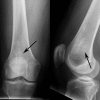A Case of Incidentally-diagnosed Erdheim-Chester Disease
- PMID: 27752407
- PMCID: PMC5063637
- DOI: 10.7759/cureus.781
A Case of Incidentally-diagnosed Erdheim-Chester Disease
Abstract
Erdheim-Chester disease (ECD) is a rare multisystemic non-Langerhans cell histiocytosis that may be clonal and inflammatory in origin. The hallmark of the disease is infiltration of various organ systems by CD68+/CD1a- histiocytes containing foamy lipid-laden inclusions. The manifestations and course of the disease are variable and depend on the organ systems that are affected. Patients may be asymptomatic or may develop life-threatening complications, including myocardial infarction. The most common clinical manifestation is lower extremity bone pain. Imaging manifestations of the disease include symmetric osteosclerosis of the distal long bones, circumferentially "coated" aorta, pleural and pericardial thickening/fluid, and perirenal encasement. Treatment for the disease is evolving, particularly with the use of molecular BRAF inhibition. We present a case of a patient with ECD initially suspected based on the imaging manifestations.
Keywords: erdheim-chester disease.
Conflict of interest statement
The authors have declared that no competing interests exist.
Figures


Similar articles
-
Erdheim-Chester disease: An elusive diagnosis in a 50-year-old Ethiopian man presenting with diffuse sclerotic bone lesion.Clin Case Rep. 2024 Sep 18;12(9):e9447. doi: 10.1002/ccr3.9447. eCollection 2024 Sep. Clin Case Rep. 2024. PMID: 39301096 Free PMC article.
-
Erdheim-Chester Disease: A Case Report and Review of the Literature.J Clin Imaging Sci. 2020 Jun 18;10:37. doi: 10.25259/JCIS_68_2020. eCollection 2020. J Clin Imaging Sci. 2020. PMID: 32637228 Free PMC article.
-
Erdheim-Chester disease: a rare cause of paraplegia.Eur J Intern Med. 2003 Feb;14(1):53-55. doi: 10.1016/s0953-6205(02)00208-x. Eur J Intern Med. 2003. PMID: 12554012
-
[Diagnosis and Treatment of Erdheim-Chester Disease -Review].Zhongguo Shi Yan Xue Ye Xue Za Zhi. 2016 Aug;24(4):1256-9. doi: 10.7534/j.issn.1009-2137.2016.04.055. Zhongguo Shi Yan Xue Ye Xue Za Zhi. 2016. PMID: 27531811 Review. Chinese.
-
Cardiovascular manifestations of Erdheim-Chester disease.Clin Exp Rheumatol. 2015 Mar-Apr;33(2 Suppl 89):S-155-63. Epub 2015 Feb 18. Clin Exp Rheumatol. 2015. PMID: 25738753 Review.
Cited by
-
Resolved heart tamponade and controlled exophthalmos, facial pain and diabetes insipidus due to Erdheim-Chester disease.BMJ Case Rep. 2018 Oct 17;2018:bcr2018225224. doi: 10.1136/bcr-2018-225224. BMJ Case Rep. 2018. PMID: 30337283 Free PMC article.
References
-
- Erdheim–Chester disease. Haroche J, Arnaud L, Cohen-Aubart F, Hervier B, Charlotte F, Emile JF, Amoura Z. Curr Rheumatol Rep. 2014;16:412. - PubMed
-
- Consensus guidelines for the diagnosis and clinical management of Erdheim-Chester disease. Diamond EL, Dagna L, Hyman DM, Cavalli G, Janku F, Estrada-Veras J, Ferrarini M, Abdel-Wahab O, Heaney ML, Scheel PJ, Feeley NK, Ferrero E, McClain KL, Vaglio A, Colby T, Arnaud L, Haroche J. Blood. 2014;124:483–492. - PMC - PubMed
-
- Erdheim-Chester disease. Clinical and radiologic characteristics of 59 cases. Veyssier-Belot C, Cacoub P, Caparros-Lefebvre D, Wechsler J, Brun B, Remy M, Wallaert B, Petit H, Grimaldi A, Wechsler B, Godeau P. Medicine (Baltimore) 1996;75:157–169. - PubMed
Publication types
LinkOut - more resources
Full Text Sources
Other Literature Sources
Research Materials
